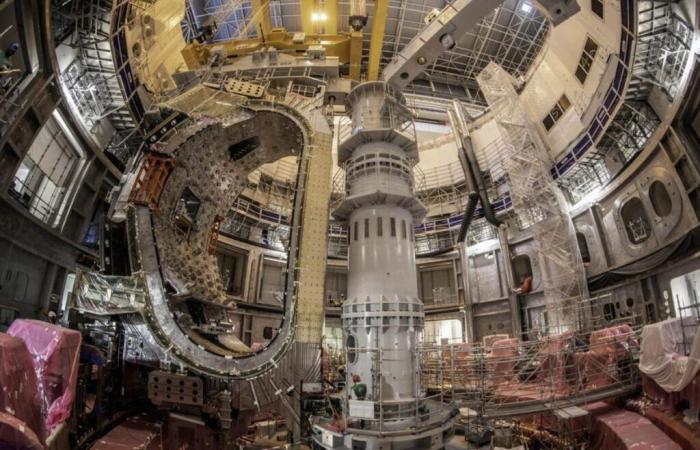A 70 -year -old problem of nuclear merger finally resolved?
It is a puzzle that haunts physicists since the beginnings of seeking nuclear fusion, an invisible but feared phenomenon: the “rebels” particles which escape from the reactor. Today, a trio of American actors: the University of Texas in Austin, the Los Alamos National Laboratory and the One -Energy type society have announced a theoretical breakthrough capable of changing the situation.
Read also:
How to trap the electrons that “flee” nuclear fusion reactors?
For a merger reactor to work, it is necessary to heat hydrogen isotopes to more than 100 million degrees. At this temperature, the material becomes plasma: a broth of electrons and ionized nuclei, more unstable than a cat in front of a cucumber.
The concern is that in this state, ultra-energy particles (such as electrons in tokamaks or alpha particles in stellarators) sometimes manage to find the exit, literally. When they escape, the whole balance of plasma is compromised. Less heat, less density, and therefore more fusion at all.
Researchers are therefore obliged to invent magnetic containment systems as effective as a good old padlock. Except that here, the padlocks must trap a vacuum heated to one billion euros per megawatt.
Germany tries the biggest “poker blow” in its energy history with 385 million euros invested in nuclear merger by inertial laser containment
A magnetic bottle full of holes
In Tokamaks and Stellarators, coils are used to generate a magnetic field that acts as an invisible cage. The plasma, although devoid of solid material around, is supposed to remain trapped in the center of the reactor.
Unfortunately this cage is not perfect. There are areas where the field weakens. Invisible holes by which particles can escape. A bit like trying to hold water with a poorly woven fishing net.
Models based on Newton laws predict these weaknesses. But the calculation is nightmarish: hundreds of thousands of simulations to manage at the same time!
Approximate, not frankly satisfactory methods
Disturbances theory is a mathematical method that allows you to find an approximate solution to a complicated problem starting from a simpler problem whose exact solution is already known. We assume that the complicated problem differs little from the simple problem, and we consider this difference as a “small disturbance”. We gradually add this disturbance and calculate how the solution changes, often using mathematical series. The lower the disturbance, the better the approximation. This method is widely used in physics, for example to study systems where it would be too difficult to find an exact solution. And that’s good, this is the case for electrons in the fusion reactors!
So, it is convenient and faster, of course, but it is also much less precise. A bit like trying to draw the metro card with a rule and a compass.
This is one of the reasons why the development of stellarators is so slow. These promising machines remain difficult to conceive, because we do not know how to predict quickly where the particles will run away.
A new theory that came to break the cycle
This is where the team led by Josh Burby intervenes. Their approach is based on a theory of symmetry, far removed from the classic calculations of Newton. The principle: observe the invariants of the system to predict trajectories without the need to calculate all possible interactions.
Their method helps keep the accuracy of Newtonian models while reducing calculation time by a factor 10. It is as if you could cook a Burgundian beef in 30 minutes, with exactly the same taste.
-And this innovation works for the two main types of reactors: Stellarators and Tokamaks.
A solution for a double problem
In the case of Tokamaks, it is not alpha particles that run away but electrons. And when they sneak up to the reactor wall, they cause damage capable of unraveling the most advanced materials.
Thanks to this new approach, it would become possible to precisely identify the risk zones, to design suitable magnetic fields, and to limit losses.
In other words, knowing “finally” where it flees and how to climb, without having to model every cube centimeter of the reactor for weeks.
A theoretical revolution in concrete applications
Josh Burby does not go there by four paths: “It is a problem open for almost 70 years. Our approach makes it possible to resolve it without sacrificing precision or exploding the calculatory budget. »»
The results, published in Physical Review Letters, open a fast track to the design of more effective reactors. And above all, less greedy in expensive error-error.
In an industry where each prototype can represent several hundred million euros, this ability to design reliable magnetic containment systems, changes the rules of the game.
The time when the electrons took themselves for escapes from Alcatraz is perhaps finally over.
France soon far away in China’s rear view mirror in its favorite sector with almost 102 nuclear reactors against only 57 in France
The latest advances in the mastery of nuclear merger
In February 2025, the French Tokamak West broke a world record by maintaining a stable melting plasma for more than 22 minutes, a crucial step for the viability of the nuclear merger. This success is added to other international advances, such as the progress of the National Ignition Facility in the United States, which approaches a self-entrepreneurial merger reaction. The ITER project, in France, recently completed major elements and aims for a first energy production around 2035-2036, paving the way for industrial demonstration reactors. Research is now focused on the resistance of materials and the management of extreme heat generated by plasma. New records of duration and power show that controlling plasma becomes more realistic, but it remains to prove the economic feasibility on a large scale. The nuclear merger is thus closer than ever, but its massive contribution to the world energy mix will wait (in the best of cases) the second half of the 21st century.
Source :
Nonperturbative Guiding Center Model for Magnetized Plasmas
J. W. Burby, I. A. Maldonado, M. Ruth, D. A. Messenger, L. Carbajal
Phys. Rev. Lett. 134, 175101 – published on April 30, 2025
DOI: https://doi.org/10.1103/PhysRevLett.134.175101
Source image : ITER








